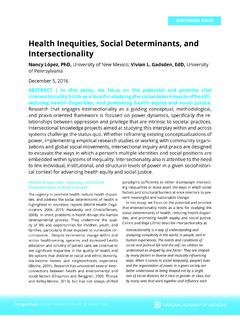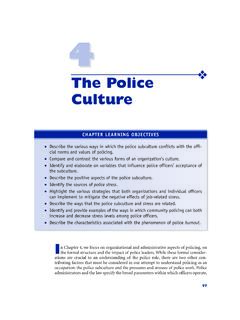Transcription of by Robin DiAngelo
1 International Journal of Critical Pedagogy, Vol 3 (3) (2011) pp 54-70 2011 International Journal of Critical PedagogyWhite FragilitybyRobin DiAngeloWhite people in North America live in a social environment that protects and in-sulates them from race-based stress. This insulated environment of racial protec-tion builds white expectations for racial comfort while at the same time lowering the ability to tolerate racial stress, leading to what I refer to as White Fragility. White Fragility is a state in which even a minimum amount of racial stress be-comes intolerable, triggering a range of defensive moves. These moves include the outward display of emotions such as anger, fear, and guilt, and behaviors such as argumentation, silence, and leaving the stress-inducing situation.
2 These behav-iors, in turn, function to reinstate white racial equilibrium. This paper explicates the dynamics of White Fragility. I am a white woman. I am standing beside a black woman. We are facing a group of white people who are seated in front of us. We are in their workplace, and have been hired by their employer to lead them in a dialogue about race. The room is filled with tension and charged with hostility. I have just presented a definition of racism that includes the acknowledgment that whites hold social and institu- tional power over people of color. A white man is pounding his fist on the table. His face is red and he is furious.
3 As he pounds he yells, White people have been discriminated against for 25 years! A white person can t get a job anymore! I look around the room and see 40 employed people, all white. There are no people White Fragility 55of color in this workplace. Something is happening here, and it isn t based in the racial reality of the workplace. I am feeling unnerved by this man s disconnection with that reality, and his lack of sensitivity to the impact this is having on my co-facilitator, the only person of color in the room. Why is this white man so angry? Why is he being so careless about the impact of his anger? Why are all the other white people either sitting in silent agreement with him or tuning out?
4 We have, after all, only articulated a definition of racism. White people in North America live in a social environment that protects and insulates them from race-based Fine (1997) identifies this insulation when she observes .. how Whiteness accrues privilege and status; gets itself surrounded by protective pillows of resources and/or benefits of the doubt; how Whiteness repels gossip and voyeurism and instead demands dignity (p. 57). Whites are rarely without these protective pillows, and when they are, it is usually temporary and by choice. This insulated environment of racial privilege builds white expectations for racial comfort while at the same time lowering the ability to tolerate racial stress.
5 For many white people, a single required multicultural education course taken in college, or required cultural competency training in their workplace, is the only time they may encounter a direct and sustained challenge to their racial understandings. But even in this arena, not all multicultural courses or training programs talk directly about racism, much less address white privilege. It is far more the norm for these courses and programs to use racially coded language such as urban, inner city, and disadvantaged but to rarely use white or over-advantaged or privileged. This racially coded language reproduces racist im-ages and perspectives while it simultaneously reproduces the comfortable illu-sion that race and its problems are what they have, not us.
6 Reasons why the facilitators of these courses and trainings may not directly name the dynamics and beneficiaries of racism range from the lack of a valid analysis of racism by white facilitators, personal and economic survival strategies for facilitators of color, and the overall pressure from management to keep the content comfortable and pal-atable for whites. However, if and when an educational program does directly address racism and the privileging of whites, common white responses include anger, withdrawal, emotional incapacitation, guilt, argumentation, and cognitive dissonance (all of which reinforce the pressure on facilitators to avoid directly addressing racism).
7 So-called progressive whites may not respond with anger, but may still insulate themselves via claims that they are beyond the need for engaging with the content because they already had a class on this or already know this. These reactions are often seen in anti-racist education endeavors as 1. Although white racial insulation is somewhat mediated by social class (with poor and working class urban whites being generally less racially insulated than suburban or rural whites), the larger social environment insulates and protects whites as a group through institutions, cultural representations, me-dia, school textbooks, movies, advertising, dominant discourses, International Journal of Critical Pedagogyforms of resistance to the challenge of internalized dominance (Whitehead & Wittig, 2005; Horton & Scott, 2004; McGowan, 2000, O Donnell, 1998).
8 These reactions do indeed function as resistance, but it may be useful to also conceptual-ize them as the result of the reduced psychosocial stamina that racial insulation inculcates. I call this lack of racial stamina White Fragility. Although mainstream definitions of racism are typically some variation of in-dividual race prejudice , which anyone of any race can have, Whiteness scholars define racism as encompassing economic, political, social , and cultural structures, actions, and beliefs that systematize and perpetuate an unequal distribution of privileges, resources and power between white people and people of color (Hil-liard, 1992). This unequal distribution benefits whites and disadvantages people of color overall and as a group.
9 Racism is not fluid in the ; it does not flow back and forth, one day benefiting whites and another day (or even era) benefiting people of color. The direction of power between whites and people of color is his-toric, traditional, normalized, and deeply embedded in the fabric of society (Mills, 1999; Feagin, 2006). Whiteness itself refers to the specific dimensions of racism that serve to elevate white people over people of color. This definition counters the dominant representation of racism in mainstream education as iso-lated in discrete behaviors that some individuals may or may not demonstrate, and goes beyond naming specific privileges (McIntosh, 1988).
10 Whites are theorized as actively shaped, affected, defined, and elevated through their racialization and the individual and collective consciousness formed within it (Frankenberg, 1997; Morrison, 1992; Tatum, 1997). Recognizing that the terms I am using are not theory neutral descriptors but theory-laden constructs inseparable from systems of injustice (Allen, 1996, ), I use the terms white and Whiteness to describe a social process. Frankenberg (1993) defines Whiteness as multi-dimensional: Whiteness is a location of structural advantage, of race privilege. Second, it is a standpoint, a place from which White people look at ourselves, at others, and at society.



